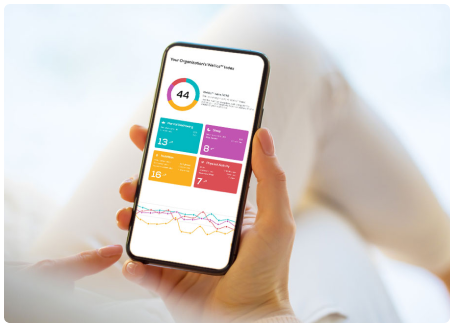What's an Employee Well-being Program?
Corporate wellbeing encompasses a set of scientifically-backed workplace practices designed to create a healthy, supportive work environment. It goes beyond the broader concept of "general wellness" by tailoring strategies specifically for the workplace, aiming to enhance employee health, boost productivity, and drive organizational success.
Unlike traditional "feel-good wellness" initiatives, corporate wellbeing focuses on a results-driven approach—delivering measurable improvements in employee well-being and tangible business outcomes. It's not just about feeling good; it’s about achieving real health and performance gains.

The Six Dimensions of Wellbeing
To improve wellbeing, we must grasp its vital components. Martin Seligman – the pioneer of positive psychology – introduced a five-aspect model addressing core life areas.





-1.png?width=591&height=879&name=Mask%20group%20(1)-1.png)
01 Physical
Originally the lack of illness, physical wellness now entails being fit, energetic, and stress-free.
It emphasizes nutrition, exercise, and healthy habits while discouraging harmful substances like drugs, tobacco, and excessive alcohol.
Adequate sleep is vital for physical well-being, with sleep deprivation linked to health issues.
02 Mental
Mental wellness is a positive, dynamic state that enables effective coping and proactive strategies in life. Cognitive abilities such as memory, attention, decision-making, and goal achievement are crucial.
Nowadays, employers recognize mental health's importance, integrating wellness activities to reduce employee stress.
03 Emotional
Emotional wellness involves maturely acknowledging, understanding, and expressing emotions. It's not constant happiness but effectively managing emotional responses, nurturing relationships, and maintaining self-esteem and resilience.
04 Spiritual
Spiritual wellness integrates purpose and meaning in life through core values, not limited to religion. It seeks harmony, compassion, moral actions, and a positive outlook, enhancing overall well-being.
05 Social
Social well-being involves positive interactions and deep relationships, impacting individuals and communities. It extends to workplaces, enhancing job satisfaction and performance.
06 Environmental
Environmental wellness involves a healthy relationship with surroundings beyond just recycling. It requires actions that protect Earth's resources and surroundings.
Understanding and nurturing these dimensions holistically create a thriving and balanced life.
Health, Well-Being, and Wellness: What's the Difference?
"What is well-being?" Initially, it's often linked with not being sick, commonly defining health as the lack of illness.Wellness and well-being stem from ancient discussions on human purpose: happiness. This ranges from instant joy (like candy) to realizing human potential (making impacts).
While both terms (well-being and wellness) are valid and reflect distinct views, wellness applies in business, while well-being gauges personal contentment, like employee wellbeing.
Can the two combine? Of course! Employee wellbeing must be central in wellness programs for happiness, health, and growth.


Key Factors That Influence Well-Being
There isn't a single solution to achieve wellness, but there are five crucial factors that impact your well-being.

Sleep
Believe it or not, quality sleep (7-9 hours) supports mood, concentration, and recovery. In contrast, sleep deprivation raises health risks like obesity and hypertension and weakens immunity.

Oxygen
Adequate oxygen intake boosts energy, immunity, and mood. Deep breathing outdoors elevates oxygen levels, benefiting stress and serotonin levels.
Nutrition
Hydration and nutrient-rich eating lower risks of diabetes and heart disease. On the other hand, dehydration leads to weakness and unhealthy cravings. Mindful eating and caffeine management aid well-being.
Activity
Physical activity (30 mins/day) can help reduce heart risks and manage weight and hormone levels. It aids in recovery and mood regulation.
Rituals
Meaningful rituals reflect values, support change, and provide structure. They enhance well-being by putting ideas into practice and combating procrastination.
Benefits of Employee Wellness Programs In the Workplace
When organizations invest in employee wellness programs, they experience long-lasting wellness benefits that extend to individuals and the company.
Employee wellness programs offer a range of benefits, such as:
01
Increased Productivity
Corporate wellness programs promote mental well-being, improving focus and performance. Initiatives such as facilitating sleep habits, healthy nutrition choices, stress management techniques, etc., contribute to higher employee productivity.
02
Improved Employee Health
Wellness initiatives help encourage better nutritional choices, reducing the risk of diseases and fostering a sense of happiness and energy. Mental health is also prioritized. Learning how certain behaviors like eating healthier snacks result in reduced stress levels and prevent burnout.
03
Lower Healthcare Costs
Investing in good employee wellness reduces healthcare expenses by up to 25%. Employees with obesity, smoking, and diabetes increase healthcare costs for businesses. Employee well-being platforms like Wellics can help significantly lower a business's healthcare costs and improve its functions and productivity.
04
Enhanced Talent Attraction
By prioritizing well-being and diversity within wellness programs, organizations can attract talent effectively. Such initiatives serve as selling points that appeal to potential employees.
05
Boosted Morale
Personalized wellness programs demonstrate care for employees, leading to increased connection and job satisfaction. This fosters loyalty among employees while enhancing productivity.
06
Increased Engagement
Employee engagement doesn't only mean taking healthy screenings, partaking in group activities, and showing up. Wellness programs create a sense of belonging among employees through community-building activities (gaming, walking) and resources. This strengthens engagement within the workplace, leading to employee retention rates.
07
Encouragement For Healthy Behavior Change
Education and training provided through wellness programs help improve the well-being of employees, including those with disabilities. From stress management tips and techniques to smoking cessation, these skills positively impact work and personal life.
08
Stress Reduction
Wellness programs equipped with stress management tools (to help employees minimize stress levels) contribute to better decision-making abilities and improved concentration levels among employees – ultimately combating burnout effectively. Reduced stress levels result in more productive teams.
09
Improved Attendance
By prioritizing well-being and effectively managing stress, corporate wellness programs contribute to an improved sense of job satisfaction, resulting in a decrease in absenteeism.
10
Improved Social Connection And Teamwork
Challenges and activities promoting wellness also play a role in building teamwork. They help foster trust and enhance social connections among employees. This camaraderie helps alleviate stress levels and boosts engagement positively, impacting overall well-being.
Benefits of Employee Wellbeing Programs In the Workplace
The impact of employee wellness is evident when we look at the statistics. Here's what research tells us:
Mental Health Impact
- Mental health costs UK employers approximately £42 £45 billion annually
- Around 53.3% of employees aged 18 to 20 experience sleep difficulties
- Insomnia/anxiety in knowledge workers costs 2.5x more
- Burnout is caused by lack of recognition (31%), unrealistic deadlines (30%), and long hours (29%)
- Work-related stress affects relationships for about 58% of manufacturing employees
- Job stress leads to unhealthy behaviors in 35% of employees, like excessive alcohol consumption
- Leaveism is common in high presenteeism organizations
- 41% report reduced productivity, 33% less engagement, 15% consider job change due to stress
Physical Health Impact
- 60% of employees report musculoskeletal pain, often in the neck, lower back, and knees
- Sedentary time links to MSD pain (11 hours/day sitting)
- 78% would use the company gym if available
Why Invest in Workplace Wellbeing?
- Effective corporate wellbeing programs cut sick days by 18% and health costs by 26% (ITA Group)
- Employee/workplace well-being impacts workforce experience (62%) and market reputation (42%)
- 78% believe employee well-being drives organizational performance
- Managers prioritize organization over staff well-being (62%)
- Early-stage supporting events and activities offer 6:1 return
Emerging Trends
- 87% engaged, 64% burned-out new employee type
- UK lockdown harmed 38% of employee well-being
- 84% of employers added COVID-19 mental health support
- 79% of employers noted leaveism with presenteeism
Suggestions for Employee Wellbeing in a Workplace Setting.
Wellbeing programs promote physical and psychological health. Crafting an effective program involves offering diverse well-being options that cater to both remote and office-based employees.
Here are some cost-effective wellness ideas to kickstart your program:
Encourage Healthy Eating
Advocate for nutrition by sharing practical tips like pre-sleep energy foods and making nutritious options accessible.
Consider introducing vending machines with wholesome snacks, sugar-free cafeteria choices, decaffeinated coffee, and discounts on healthy foods. Theme days like Healthy Eating (employees cook healthy recipes) and "Meat-Free Monday" can also foster awareness.
Create Wellness Challenges
Engage employees with enjoyable activities that encourage interaction and competition. Initiatives like 30-day weight loss challenges or step competitions complete with rewards can spark motivation.
A wellness scoreboard, like awarding additional points for physical activities and spontaneous challenges such as who has healthier snacks, can also drive participation.
Encourage Social Connection
Foster a sense of belonging and promote engagement with activities such as group runs or meditation sessions. Embrace neurodiversity for a more inclusive work environment.
Walking Meetings
Break the monotony of lengthy meetings by allowing walking discussions outdoors or at nearby parks.
Stress Management Support
Facilitate stress management through support groups led by professionals. Sharing experiences enhances empathy and normalizes struggles.
Flexible Hours
Adapt to post-pandemic realities by offering core work hours and flexible scheduling, promoting work-life balance and trust.
Lunch & Learn
Encourage learning and camaraderie by inviting employees to share their interests during lunchtime presentations.
Monthly Wellness Email
Keep wellness accessible through a monthly newsletter with links to videos, articles, and updates on challenges.
Company Retreats
Organize retreats to rejuvenate employees and foster team building, aligning with work-life balance.
Screen Breaks
Educate on the productivity benefits of regular short breaks, destigmatizing pauses, and enhancing focus. Many productive people tend to work actively for 52 minutes and take breaks for 17 minutes.
Ergonomics Investment
Invite experts in workspace ergonomics and provide ergonomic setups, including standing desks and proper computer equipment to enhance employee comfort.
Weight Management Challenge
Offer a three-month weight management challenge program with achievable goals and consistent rewards.
Employee Surveys
Gather feedback through surveys to tailor wellness offerings to employee preferences, fostering engagement.
Wellness Reminders
Decorate the workspace with motivational content that changes monthly or based on ongoing challenges.
Wellness Board
Create a platform for employees to express thoughts and emotions through drawings or posts, enhancing awareness.
Gratitude Practice
Encourage daily gratitude sharing via Google Sheets or office gratitude jars, promoting positivity. Keep the content open for all to read or share before monthly meetings.
No Work Zone
Designate a space where employees can unwind without discussing work. This helps foster relaxation.
A comprehensive wellness program integrating these ideas can positively impact employees' overall health, morale, and engagement.
How to Establish and Design a Corporate Wellness Program?
Crafting a successful corporate wellness program requires careful planning and expertise from a wellness manager or certified professional. Such programs aim to enhance employee well-being and productivity while curbing health-related expenses.
To design such a program, you need to:
Engage a Wellness Champion
Believe it or not, quality sleep (7-9 hours) supports mood, concentration, and recovery. In contrast, sleep deprivation raises health risks like obesity and hypertension and weakens immunity.
Know Your Audience
Adequate oxygen intake boosts energy, immunity, and mood. Deep breathing outdoors elevates oxygen levels, benefiting stress and serotonin levels.
Allocate Resources
Hydration and nutrient-rich eating lower risks of diabetes and heart disease. Dehydration leads to weakness and unhealthy cravings. Mindful eating and caffeine management aid well-being.
Choose Interventions
Physical activity (30 mins/day) can help reduce heart risks and manage weight and hormone levels. It aids in recovery and mood regulation.
Set A Timeline
Meaningful rituals reflect values, support change, and provide structure. They enhance well-being by putting ideas into practice and combating procrastination.
Effective Communication
Meaningful rituals reflect values, support change, and provide structure. They enhance well-being by putting ideas into practice and combating procrastination.
Evaluation Plan
Meaningful rituals reflect values, support change, and provide structure. They enhance well-being by putting ideas into practice and combating procrastination.
Employee Wellness Surveys
The employee wellbeing surveys seek input on well-being and organizational policy. They offer insights on corporate wellness efforts, helping you make informed choices.
Tailor questions for desired information. Since employee well-being evolves, frequent updated surveys can help enhance outcomes.
To create an effective wellbeing program, gather data on:
- Demographics
- Physical activity
- Nutrition
- Health screening
- Interests
- Habits
- Mental agility/fitness
Sample survey questions for reference:
- Rate your physical health: Poor to Excellent
- Recent medical exams: Blood pressure, flu shot, cholesterol, etc.
- Frequency of stress-reducing techniques: Never to often
- Agree/disagree on a scale of 1-5: My health is good
- Agree/disagree on a scale of 1-5: I'm as healthy as people I know
- Agree/disagree: "It's easier to get ill than others" (1-5)
- Agree/disagree on a scale of 1-5: Impact of stress on health
How Much Does an Employee Wellbeing Program Cost?


Wellness programs may involve various things, from basic biometric screening and wellness platforms to tailored resources or even incentives like bonuses to promote higher engagement with employee wellness activities.
To know if it's worthwhile, calculate your program's ROI. For instance, Unilever's mental health initiative yielded an ROI of 3.50 to 1 in 2013, which is remarkable.
Also, Wellics provides clear and flexible pricing, promising transparency with no hidden fees. We guarantee measurable results and a visible return on investment, evident in improved performance metrics and team satisfaction.
8 Features Every Wellbeing Platform Should Have
A wellbeing platform is a tool to help employers implement wellbeing strategies.
Wellics is science-backed and evidence-based.
Our platform uses machine learning with employees' lifestyle data to calculate the Wellics™ Index (WIN) that measures sleep, mental well-being, nutrition, and physical activity.
Subsequently, the WIN informs organizations about employee well-being, facilitating informed decisions and interventions.
Explore Our Employee Wellness PlatformNevertheless, here are a few features to consider in an employee wellness platform:
Health Assessments
Change requires awareness. Health assessments – commonly performed through biometric screening – help establish baselines for employee health. They help track progress and risk identification.
Employee Education
Equipping employees with lifestyle and health knowledge, successful platforms offer audio, videos, and feedback for an informed wellness journey. For example, Wellics offers a weekly micro-coaching curriculum rooted in unique scientific content that helps HR departments foster employee well-being-oriented lifestyle changes.
Engagement
User-friendly websites and mobile apps boost daily engagement, simplifying resource usage and monitoring.
Reward System
Content
Psychoeducational tools break down 'how-to' barriers to adopting healthy lifestyles
Social Connection
Fostering community and social interaction enhances overall well-being and motivation
Challenges
Short-term goals via challenges drive behavioral changes and healthy habits. Wellics offers a range of pre-designed challenges to enhance corporate well-being strategies, fostering employee engagement. These challenges cater to individuals, peer-to-peer interactions, and team involvement, enabling organizations to customize participation levels.
Participation Dashboard
Managers and employees access activity and progress tracking, which is vital for sustaining momentum and assessing program success. Comprehensive insights, including participation rates and effectiveness, make the dashboard a cornerstone of any wellness platform.
Frequently asked questions
Whether you're an employee or an employer, this FAQ section will help you better understand health, well-being, and wellness.
I'd Like to Initiate Discussions About My Employees' Well-Being. How Can I Begin? Are There Any Reputable Organizations That Offer Guidance?
You may consider checking out the CIPD (Chartered Institute of Personnel and Development) and the Mental Health Foundation. They provide valuable resources for approaching employee mental health conversations.
What Sets Holistic Well-Being Apart?
You may consider checking out the CIPD (Chartered Institute of Personnel and Development) and the Mental Health Foundation. They provide valuable resources for approaching employee mental health conversations.
I Prefer Not to Disclose My Mental Health Details to My Employer. What Are My Options?
You may consider checking out the CIPD (Chartered Institute of Personnel and Development) and the Mental Health Foundation. They provide valuable resources for approaching employee mental health conversations.
What's Cumulative Stress?
You may consider checking out the CIPD (Chartered Institute of Personnel and Development) and the Mental Health Foundation. They provide valuable resources for approaching employee mental health conversations.
I'm Often Fatigued Despite Having No Health Issues. Why?
You may consider checking out the CIPD (Chartered Institute of Personnel and Development) and the Mental Health Foundation. They provide valuable resources for approaching employee mental health conversations.
What Are the Leading Corporate Wellness Platforms?
You may consider checking out the CIPD (Chartered Institute of Personnel and Development) and the Mental Health Foundation. They provide valuable resources for approaching employee mental health conversations.


